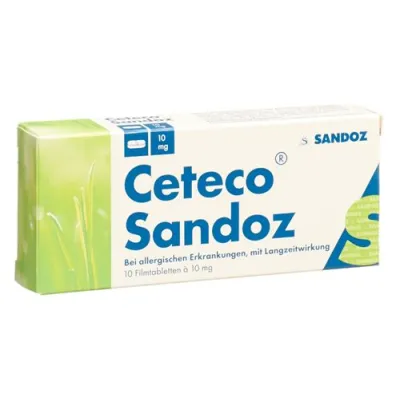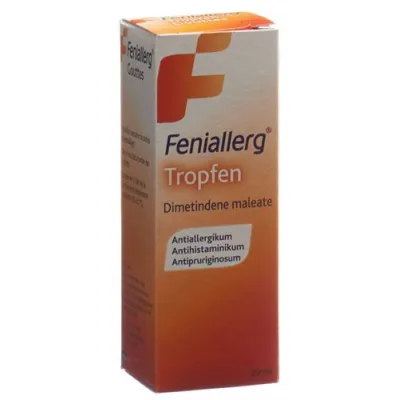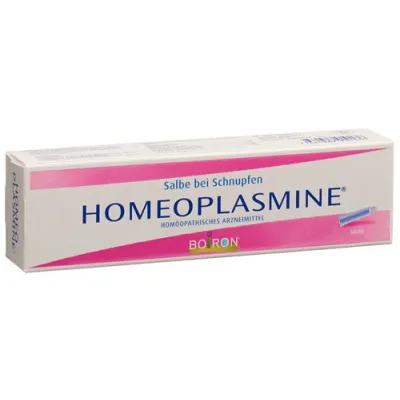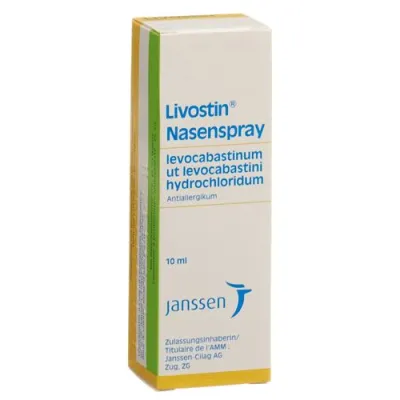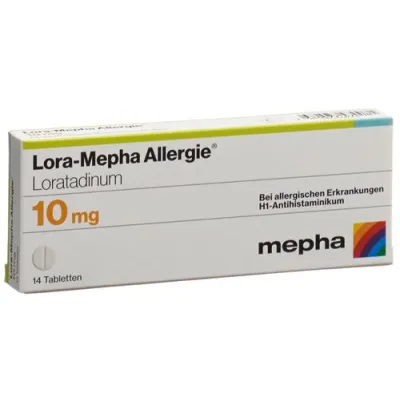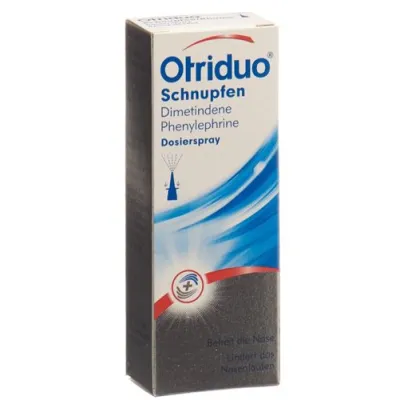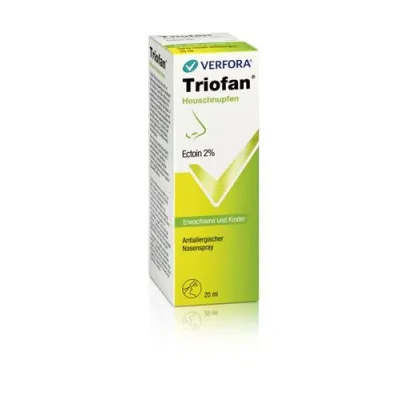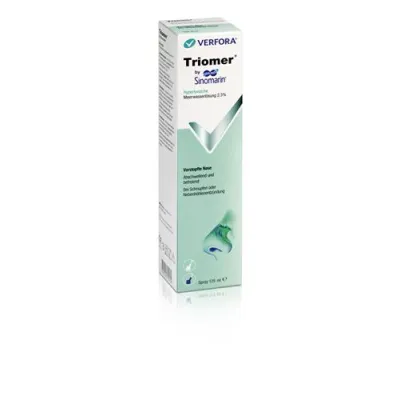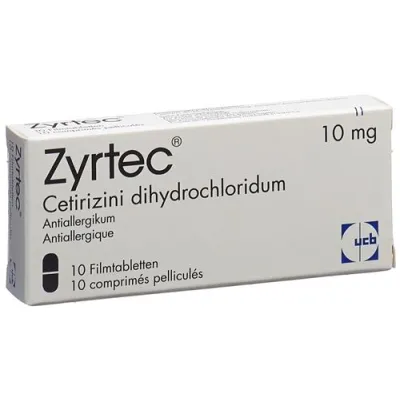Allergic rhinitis
(1 Pages)
Ceteco sandoz film-coated tablets 10 mg 10 pcs
What Ceteco Sandoz is and what it is used forCeteco Sandoz is effective in the basic treatment of allergic diseases. It blocks the action of histamine, which is released in the body during allergic reactions. Ceteco Sandoz is used in adults and children from 6 years of age to treat allergic diseases such as hay fever, allergic rhinitis and allergic conjunctivitis and chronic hives (which are often associated with itching). The treatment duration for children with allergic rhinitis must not exceed 4 weeks. Ceteco Sandoz is available in the form of film-coated tablets or drops.When should Ceteco Sandoz not be taken?Patients who are hypersensitive to the active substance, other related substances or any other component of Ceteco Sandoz should not use the preparation.Women who are breastfeeding should not use Ceteco Sandoz. Pregnant women should only take Ceteco Sandoz if prescribed by a doctor.Since Ceteco Sandoz film-coated tablets contain lactose, patients with rare hereditary disorders such as galactose intolerance, the Lapp lactase deficiency or glucose-galactose malabsorption syndrome should not take the film-coated tablets.Patients with end-stage kidney disease (with a glomerular filtration rate (GFR) below 15 ml/min) should not take Ceteco Sandoz.When is caution required when taking Ceteco Sandoz?Children under 6 years of age should not be treated with Ceteco Sandoz. You should only take Ceteco Sandoz film-coated tablets and theophylline (an active substance used to treat shortness of breath) after consulting your doctor. Ceteco Sandoz and preparations containing glipizide (a drug used to treat diabetes) should not be taken together. It is recommended to take the Glipizide medication in the morning and Ceteco Sandoz in the evening.Ceteco Sandoz should be used with caution in epileptics as it could potentially trigger seizures.Caution should be exercised when using Ceteco Sandoz at the same time as sedatives or painkillers.Caution should be exercised when driving a motor vehicle or using machines as taking Ceteco Sandoz may make you drowsy.It is advisable not to drink alcohol during treatment with Ceteco Sandoz.If you are going to have an allergy test, ask your doctor if you should stop taking Ceteco Sandoz for a few days before the test, as this medicine could affect the result of an allergy test.Ceteco Sandoz can increase the risk of urinary retention in patients with a tendency to urinary retention (such as spinal cord injury, prostate enlargement).Tell your doctor, pharmacist or druggist if yousuffer from other diseaseshave allergies orare taking other medicines (including those you bought yourself!).Can Ceteco Sandoz be taken during pregnancy or while breastfeeding?No undesirable effects have been found in animal experiments. However, like other medicines, Ceteco Sandoz should not be taken during pregnancy. If you accidentally take Ceteco Sandoz during pregnancy, no harmful effects on the unborn child are to be expected, but the treatment should be stopped immediately. Talk to your doctor if you are pregnant or planning to become pregnant. Ceteco Sandoz should not be taken during breast-feeding as the active ingredient passes into breast milk.How do you use Ceteco Sandoz?For adults and children over 6 years: The usual dose is one Ceteco Sandoz film-coated tablet once a day. For children from 6 to 12 years of age, the dosage can be divided into two intakes (half a film-coated tablet in the morning and half in the evening). If slight side effects (tiredness, headaches, gastrointestinal disorders) occur that do not resolve on their own, it is also advisable for adults to take half a film-coated tablet in the morning and half in the evening.Patients with moderate to severe renal impairmentPatients with impaired kidney function (kidney failure) may receive a lower dose, which depends on the severity of the kidney disease and is determined by the doctor treating you. The Ceteco Sandoz film-coated tablets should be swallowed whole with a glass of liquid.Ceteco Sandoz can be taken with or without food. The duration of treatment depends on the type, duration and course of the symptoms and is determined by the doctor. If you forget to take a dose of Ceteco Sandoz, simply continue the treatment. Please do not take a double dose to make up for a missed dose. In the event of an overdose, you should contact your doctor immediately.Follow the dosage given in the package leaflet or prescribed by your doctor. If you think the medicine is too weak or too strong, talk to your doctor, pharmacist or druggist.What side effects can Ceteco Sandoz have?The following side effects can occur when taking Ceteco Sandoz:Common (affects 1 to 10 users in 100)Mild tiredness, mild headache, drowsiness, dizziness, dry mouth, nausea have been reported.Uncommon (affects 1 to 10 users in 1000)Gastrointestinal disorders (e.g. diarrhea, abdominal pain), feeling unwell, itching, rash, agitation, abnormal sensations on the skin, runny nose, sore throat, feeling weak.Rare (affects 1 to 10 users in 10,000)Hypersensitivity reactions, seizures, circulatory failure, liver damage, urticaria (nettle rash), tachycardia, edema (swelling), weight gain, confusion, hallucinations, insomnia, aggression, extreme tiredness, depression.Very rare (affects less than 1 in 10,000 people)Movement disorders, tremors, nervous twitches (tics), photosensitivity reactions, allergic shock, urination disorders (abnormal urination), visual disturbances and uncontrollable circling movements of the eyes, thrombocytopenia (low blood platelet count), dysgeusia (altered sense of taste), syncope (fainting).Frequency not known (cannot be estimated from the available data)Loss of memory (amnesia), memory problems, difficulty concentrating, dizziness (sensation of spinning or moving), urinary retention, increased appetite, suicidal thoughts, nightmares, joint pain, muscle pain, acute skin rash over the whole body with pustules and liver inflammation, vasculitis, hearing loss.Pruritus and/or urticaria have been reported following discontinuation of cetirizine.If you experience any of these side effects, stop taking Ceteco Sandoz and tell your doctor.If you notice side effects, contact your doctor, pharmacist or druggist. This also applies in particular to side effects that are not listed in this leaflet.What should also be noted?DurabilityThe medicinal product may only be used up to the date marked “EXP” on the package.Storage NoticeStore in the original packaging, at room temperature (15-25°C) and out of the reach of children.More informationYour doctor, pharmacist or druggist can provide you with further information. These people have the detailed information for specialists.What does Ceteco Sandoz contain?1 film- coated tablet (divisible) contains 10 mg cetirizine dihydrochloride as an active ingredient and excipients.Registration Number57360 (Swissmedic)Where can you get Ceteco Sandoz? What packs are available?You can get Ceteco Sandoz in packs of 10 film-coated tablets in pharmacies and drugstores without a doctor's prescription.Marketing Authorization HolderSandoz Pharmaceuticals AG, Risch; Domicile: Red Cross..
21.60 USD
Feniallerg drops 1 mg/ml bottle 20 ml
Feniallerg blocks the action of histamine, one of the substances released during allergic reactions. Feniallerg relieves itching and skin irritation caused by allergic reactions, reduces edema (abnormal accumulation of fluid in the skin or mucous membranes) and relieves the symptoms of nasal allergic such as runny nose, tearing and sneezing. Feniallerg is used in the following cases: for allergic skin conditions: itching of various origins (except itching associated with jaundice), eczema and other itchy skin diseases, nettle fever, itching associated with diseases with skin rashes such as chickenpox; for insect bites; for allergic diseases of the upper respiratory tract:hay fever and other forms of nasal allergic; for the treatment of symptoms caused by food or drug allergies. Swissmedic-approved patient information Feniallerg GSK Consumer Healthcare Schweiz AG What is Feniallerg and when is it used? Feniallerg inhibits the effects of histamine, a of the substances released in allergic reactions. Feniallerg relieves itching and skin irritation caused by allergic reactions, reduces edema (abnormal accumulation of fluid in the skin or mucous membranes) and relieves the symptoms of nasal allergic such as runny nose, tearing and sneezing. Feniallerg is used in the following cases: for allergic skin diseases: itching of various origins (except itching associated with jaundice), eczema and other itchy skin diseases, nettle fever, itching associated with diseases with skin rashes such as chickenpox; for insect bites;for allergic diseases of the upper respiratory tract:hay fever and other forms of nasal allergic;for the treatment of symptoms caused by food or drug allergies.When should Feniallerg not be used?You must not use Feniallerg if you are allergic (hypersensitive) to the active substance dimetinden maleate or any of the excipients . Feniallerg should not be used in newborn babies less than 1 month old, especially premature babies. Talk to your doctor or pharmacist if the above applies, because then Feniallerg is not suitable for you. When is caution required when using Feniallerg?Inform your doctor or pharmacist before taking Feniallerg drops if you glaucoma,urinary retention (e.g. due to an enlarged prostate),epilepsy, suffer from chronic obstructive pulmonary disease or other diseases.Elderly patients should consult their doctor before taking this medicine, as side effects such as agitation and tiredness may occur. If you are taking any of the following medicines, you should only take Feniallerg after consulting your doctor: Medicines for depression (MAOIs or tricyclic antidepressants),Anticholinergics such as bronchodilators (medicines used to treat asthma or bronchospasm), gastrointestinal antispasmodics (medicines used to treat stomach intestinal spasms), mydriatics (medicines to dilate the pupil), urological antispasmodics (medicines to treat the symptoms of urinary incontinence or an overactive bladder),medicines that depress the central nervous system (such as sedatives or sleeping pills), Medicines for epilepsy, painkillers (strong painkillers),Antihistamines (medicines used for coughs, colds or allergies),Antiemetics (medicines against vomiting),Procarbazine (medicine to treat certain types of ),Scopolamine (medicine to prevent motion sickness),if alcohol is taken at the same time.This medicine can impair your ability to react, the ability to drive and the ability to use tools or machines! Like other antihistamines, Feniallerg can increase the effects of alcohol. In small children from 1 month to 1 year, Feniallerg may only be used on medical recommendation. The recommended dosage must not be exceeded. The depressant effect may be accompanied by pauses in breathing during sleep. Antihistamines can trigger states of excitement, especially in children and elderly patients. This medicinal product contains propylene glycol 100 mg/ml (or per 20 drops). This medicinal product contains benzoic acid 1 mg/ml (or per 20 drops). This medicinal product contains less than 1 mmol (=23 mg) sodium per 1 ml (or per 20 drops), i.e. essentially 'sodium-free'. it is almost «sodium-free». Tell your doctor, pharmacist or druggist if you suffer from other diseases,have allergies oruse other medicines (including those you bought yourself!)! Can Feniallerg be used while pregnant or breastfeeding?If you are pregnant, you should not take Feniallerg unless your doctor has told you to. Taking Feniallerg while breastfeeding is not recommended. If you are pregnant or breast-feeding, think you may be pregnant or planning to become pregnant, consult your doctor before taking this medicine. How do you use Feniallerg?Adults and adolescents over 12 yearsRecommended daily dose:drops 1 mg/ml: 20-40 drops, 3 times a day. ChildrenIn small children from 1 month to 1 year, Feniallerg drops may only be used as recommended by a doctor. The recommended daily dose is:2 drops per kg of body weight per day, divided into 3 intakes. Age/WeightDose in drops 1 month - 1 year / 4.5 - 15 kg 3-10 drops, 3 times a day 1-3 years / 15-22.5 kg 10-15 drops, 3 times a day 3-12 Years / 22.5-30kg 15-20 drops, 3 times a day The optimal dose will be determined by your doctor. The Feniallerg drops are sensitive to heat. Therefore, add the drops to the lukewarm baby bottle at the last moment. If the child can already eat with a spoon, give him the pleasant-tasting drops undiluted with a teaspoon. Feniallerg, drops should not be taken for more than 14 days without medical advice. If you have taken too much Feniallerg: Talk to your doctor or pharmacist immediately. If you miss a dose: Take Feniallerg as soon as you remember, unless it is less than 2 hours until the scheduled dose. In this case you should not take the missed dose but take the next dose at the usual time according to the dosing schedule. Do not take a double dose to make up for the missed dose. Stick to the dosage given in the package leaflet or as prescribed by your doctor. If you think the medicine is too weak or too strong, talk to your doctor, pharmacist or druggist. What side effects can Feniallerg have?Like all medicines, Feniallerg can cause side effects, although not everyone gets them. Stop taking Feniallerg and tell your doctor straight away if you get any of the following symptoms, which may be signs of an allergic reaction: difficulty breathing or swallowing,swelling of the face, lips, tongue or throat,severe itching of the skin with a red rash or blisters, muscle spasms .These side effects are very rare (affects less than 1 in 10,000 people). Other side effects are usually mild and temporary. They occur mainly at the beginning of treatment. Very common (affects more than 1 in 10 people)Fatigue Common (affects 1 to 10 users in 100)Drowsiness, nervousnessRare (affects 1 to 10 users in 10,000)Excitement, headache, dizziness, gastrointestinal disorders such as vomiting, dry mouth or throat. If you get any side effects, talk to your doctor, pharmacist or druggist. This also applies in particular to side effects that are not listed in this leaflet. What else needs to be considered?Shelf lifeThe medicinal product may only be used up to the date marked on the container with ‹ EXP› are used. Storage instructionsProtect from light and store at room temperature (15-25°C). Keep out of the reach of children. Further informationYour doctor, pharmacist or druggist can provide you with further information. These people have the detailed information for specialists. What does Feniallerg contain?1 ml of Feniallerg oral drops, solution contains Active ingredient1 mg dimetindene maleate. ExcipientsBenzoic acid (E 210), propylene glycol (E 1520), disodium phosphate dodecahydrate (E 339), citric acid monohydrate (E 330), sodium edetate, saccharin Sodium (E 954), purified water. Approval number27528 (Swissmedic) Where can you get Feniallerg? What packs are available?In pharmacies and drugstores, without a doctor's prescription. Packs of 20 and 50 ml. Authorization holderGSK Consumer Healthcare Schweiz AG, Risch. This leaflet was last checked by the Medicines Agency (Swissmedic) in June 2021. ..
16.26 USD
Homeoplasmine ointment tube 40 g
Swissmedic-approved patient information Homéoplasmine® ointment Boiron SA Homeopathic medicine When is Homéoplasmine used? According to homeopathic medicinal products, Homéoplasmine can be used to treat irritation of the nasal mucosa caused by a cold, chronic or allergic rhinitis and inflammation of the skin and mucous membranes in the nasal area. What should be considered? If your doctor has prescribed other medicines for you, ask your doctor or pharmacist whether Homéoplasmine may be used at the same time. When should Homéoplasmine not be used or only with caution? Homéoplasmine should not be used if there is a known hypersensitivity to composite plants (e.g. arnica, marigold) or to any of the other ingredients . Tell your doctor, pharmacist or druggist if you suffer from other illnesses have allergies or take other medicines (including those you bought yourself!) or use them externally! Can Homéoplasmine be used during pregnancy or breastfeeding? Based on previous experience, there is no known risk for the child when used as directed. However, systematic scientific investigations have never been carried out. As a precaution, you should avoid taking medicines during pregnancy and breastfeeding or ask your doctor, pharmacist or druggist for advice. How do you use Homéoplasmine? Unless otherwise prescribed by the doctor: apply the ointment to each nostril in the morning and evening in the event of nasal irritation. Follow the dosage given in the package leaflet or prescribed by your doctor. If the desired improvement does not occur during the treatment of a small child/child, a doctor should be consulted with him or her. If you think the medicine is too weak or too strong, talk to your doctor, pharmacist or druggist. What side effects can Homéoplasmine have? When taking homeopathic medicines, the symptoms can temporarily worsen (initial aggravation). If the deterioration persists, discontinue Homéoplasmine and tell your doctor, pharmacist or druggist. In rare cases of hypersensitivity to the components, local reactions may occur. In these cases, the treatment should be interrupted and a doctor consulted. If you get any side effects, talk to your doctor, pharmacist or druggist. This also applies in particular to side effects that are not listed in this leaflet. What else needs to be considered? The medicinal product may only be used up to the date marked "EXP" on the container. Store at room temperature (15-25°C). Keep out of reach of CHILDREN. Your doctor, pharmacist or druggist can provide you with further information. What does Homéoplasmine contain? 1 g of ointment contains: Benzoin resin TM (siam benzoin) 1 mg, Bryonia cretica (dioica) TM (dioecious bryony) 1 mg, Calendula officinalis TM (marigold) 1 mg, Phytolacca americana (decandra) TM (pokeweed) 3 mg. This preparation also contains the auxiliary substance white Vaseline. Approval number 44791 (Swissmedic). Where can you get homeoplasmins? What packs are available? In pharmacies and drugstores, without a doctor's prescription. Tube of 40 grams. Authorization holder BOIRON AG, CH-3007 Bern. Manufacturer BOIRON AG – France. This leaflet was last checked by the drug authority (Swissmedic) in December 2003. Swissmedic-approved patient information Homéoplasmine® ointmentBoiron SAHomeopathic medicinal product When is Homéoplasmine used?According to homeopathic medicinal products, Homéoplasmine can be used to treat irritation of the nasal mucosa caused by a cold, chronic or allergic rhinitis and inflammation of the skin and mucous membranes in the nasal area. What should be considered?If your doctor has prescribed other medicines for you, ask your doctor or pharmacist whether Homéoplasmine may be used at the same time. When should Homéoplasmine not be used or only with caution?Homéoplasmine should not be used if there is a known hypersensitivity to composite plants (e.g. arnica, marigold) or to any of the other ingredients . Tell your doctor, pharmacist or druggist if you suffer from other diseaseshave allergies ortake other medicines (including those you bought yourself!) or use them externally!Can Homéoplasmine be used during pregnancy or breastfeeding?Based on previous experience, there is no known risk for the child when used as directed. However, systematic scientific investigations have never been carried out. As a precaution, you should avoid taking medicines during pregnancy and breastfeeding or ask your doctor, pharmacist or druggist for advice. How do you use Homéoplasmine?Unless otherwise prescribed by the doctor: apply the ointment to each nostril in the morning and evening in the event of nasal irritation. Follow the dosage given in the package leaflet or prescribed by your doctor. If the desired improvement does not occur during the treatment of a small child/child, a doctor should be consulted with him or her. If you think the medicine is too weak or too strong, talk to your doctor, pharmacist or druggist. What side effects can Homéoplasmine have?When taking homeopathic medicines, the symptoms can temporarily worsen (initial aggravation). If the deterioration persists, discontinue Homéoplasmine and tell your doctor, pharmacist or druggist. In rare cases of hypersensitivity to the components, local reactions may occur. In these cases, the treatment should be interrupted and a doctor consulted. If you get any side effects, talk to your doctor, pharmacist or druggist. This also applies in particular to side effects that are not listed in this leaflet. What else needs to be considered?The medicinal product may only be used up to the date marked «EXP» on the container. Store at room temperature (15-25°C). Keep out of reach of CHILDREN. Your doctor, pharmacist or druggist can provide you with further information. What does Homéoplasmine contain?1 g of ointment contains: Benzoin resin TM (siam benzoin) 1 mg, Bryonia cretica (dioica) TM (dioecious bryony) 1 mg, Calendula officinalis TM (marigold) 1 mg, Phytolacca americana (decandra) TM (pokeweed) 3 mg. This preparation also contains the auxiliary substance white Vaseline. Approval number44791 (Swissmedic). Where can you get homeoplasmins? What packs are available?In pharmacies and drugstores, without a doctor's prescription. Tube of 40 grams. Authorization holderBOIRON AG, CH-3007 Bern. ManufacturerBOIRON AG – France. This leaflet was last checked by the drug authority (Swissmedic) in December 2003. ..
36.13 USD
Livostin nasal spray 0.05% fl 10ml
Livostin Nasal Spray is a medicine used to treat seasonal allergies in the nose. Its effects start immediately and last for several hours. Livostin quickly relieves the typical signs of allergic rhinitis (e.g. hay fever), such as sneezing, itching in the nose and nasal discharge. Swissmedic-approved patient informationLivostin® Nasal SprayJanssen-Cilag AGWhat is Livostin Nasal Spray and when is it used?Livostin Nasal Spray is a medicine used to treat seasonal allergies in the nose. Its effects start immediately and last for several hours. Livostin quickly relieves the typical signs of allergic rhinitis (e.g. hay fever), such as sneezing, itching in the nose and nasal discharge. When should Livostin Nasal Spray not be used?If you are hypersensitive to any of the ingredients, Livostin Nasal Spray should not be used. Livostin Nasal Spray should not be used if you have severe kidney dysfunction (kidney failure). If you are unsure, ask your doctor, pharmacist or druggist. When is caution required when using Livostin nasal spray?If you suffer from kidney dysfunction, the doctor, pharmacist or druggist must be made aware of it. Do not use Livostin Nasal Spray for more than 2 weeks without a prescription. If the symptoms persist after this time, the doctor should be consulted. If prescribed by the doctor, the preparation can be used for longer than 2 weeks. In this case, it should not be used for more than 2 months with regular use. Children under the age of 6 should not use Livostin Nasal Spray. In general, Livostin Nasal Spray does not affect alertness or concentration. However, if you feel drowsy, be careful when driving or using machines. Tell your doctor, pharmacist or druggist if you suffer from other illnesses,have allergies ortake other medicines (including those you bought yourself!) or use them externally!Can Livostin Nasal Spray be used during pregnancy or while breastfeeding?Based on previous experience, there is no known risk for the child when used as directed. However, systematic scientific studies have never been carried out. Livostin nasal spray should not be used during pregnancy unless the doctor considers it absolutely necessary. This also applies to breastfeeding. How do you use Livostin Nasal Spray?Unless otherwise prescribed by your doctor, Livostin Nasal Spray is used as follows: Adults and children over 6 years of age:2 sprays per nostril twice a day. Before using for the first time, press down the spray head several times after removing the protective cap until a fine mist comes out. Blow your nose thoroughly and shake the bottle before each use. Insert the metered dose spray into the nostril. Hold the free nostril closed and inhale through your nose while depressing the spray head. Repeat on the other nostril. Stick to the dosage given in the package leaflet or as prescribed by your doctor. If you think the medicine is too weak or too strong, talk to your doctor, pharmacist or druggist. What side effects can Livostin Nasal Spray have?A very common side effect when using Livostin Nasal Spray is a headache. The following side effects can also occur frequently when using Livostin Nasal Spray: Inflammation of the paranasal sinusesDrowsinessFatigueDizzinessFeeling sickPain the application siteSore throatNosebleedsCoughThe following side effects have been reported uncommonly: HypersensitivityPalpitationGeneral malaiseShortness of breathOccasionally to very rarely are also the the following side effects occurred: Stuffy noseNasal discomfortIrritation, discomfort, pain, burning or dryness at the application siteRarely has also been reported the following side effects: Rapid heartNasal swellingIn individual cases, the following side effects were also observed: Constriction of the airwaysAllergic hypersensitivity reactionsSwelling of the eyelidIf you get any side effects, talk to your doctor , pharmacist or druggist or your doctor, pharmacist or druggist. This also applies in particular to side effects that are not listed in this leaflet. What else should be considered?Keep out of the reach of children! Store at room temperature (15-25°C). The medicinal product may only be used up to the date marked «EXP» on the container. Close the bottle immediately after use. Your doctor, pharmacist or druggist can provide you with further information. These people have the detailed information for specialists. What does Livostin Nasal Spray contain?Active ingredient: Levocabastine (as hydrochloride). Microsuspension, containing: 0.5 mg levocabastine/ml. Excipients: propylene glycol; Preservative: benzalkonium chloride. Approval number50497 (Swissmedic). Where can you get Livostin nasal spray? What packs are available?In pharmacies and drugstores, without a doctor's prescription. 10 ml dosing spray. Authorization holderJanssen-Cilag AG, Zug, ZG. This leaflet was last checked by the drug authority (Swissmedic) in December 2013. ..
46.33 USD
Lora-mepha allergy tablets 10 mg 14 pcs
Lora-Mepha Allergy is a preparation for the treatment of allergic diseases. It has a long-lasting, blocking effect on histamine, which is released in the body during allergic reactions. The long duration of action means that it can be taken once a day. In the usual dosage, Lora-Mepha Allergy does not usually impair the ability to perform or concentrate and also does not usually make you sleepy. Lora-Mepha Allergy is used in adults and adolescents from the age of 12 for the preventive and symptomatic treatment of hay fever, chronic allergic rhinitis, allergic conjunctivitis and chronic hives (urticaria). Swissmedic-approved patient informationLora-Mepha allergy tablets Mepha Pharma AG What is Lora-Mepha allergy and when is it used? Lora-Mepha Allergy is a preparation used to treat allergic diseases. It has a long-lasting, blocking effect on histamine, which is released in the body during allergic reactions. The long duration of action means that it can be taken once a day. In the usual dosage, Lora-Mepha Allergy does not usually impair the ability to perform or concentrate and also does not usually make you sleepy. Lora-Mepha Allergy is used in adults and adolescents from the age of 12 for the preventive and symptomatic treatment of hay fever, chronic allergic rhinitis, allergic conjunctivitis and chronic hives (urticaria). When should Lora-Mepha Allergy not be taken?In case of known hypersensitivity to the active substance of Lora-Mepha Allergy or one of the ingredients. When is caution required when taking Lora-Mepha Allergy?Taking higher doses can lead to sedation (tiredness, sleepiness). When driving a motor vehicle or operating machinery, the recommended dosage should not be exceeded. The depressant effect of alcohol or diazepam is not increased by Lora-Mepha allergy. If you suffer from liver dysfunction, the doctor will usually reduce the dose, i. You only take Lora-Mepha Allergy every other day. Please only take Lora-Mepha Allergy after consulting your doctor if you know that you suffer from a sugar intolerance. Inform your doctor, pharmacist or druggist if you suffer from other illnesses, have allergies or are taking other medicines (even those you bought yourself!) or using them externally. Can Lora-Mepha Allergy be taken while pregnant or breastfeeding?If you are pregnant or breast-feeding, taking Lora-Mepha Allergy is not recommended. Ask your doctor, pharmacist or druggist for advice before taking any medicines while you are pregnant or breastfeeding. How do you use Lora-Mepha Allergy?Adolescents from the age of 12 and adultsOnce a day 1 Tablet Lora-Mepha Allergy. Correct way of takingYou can take it regardless of the time of day. In order to achieve the fastest possible onset of action, you should take Lora-Mepha Allergy on an empty stomach. If you prefer to take Lora-Mepha Allergy with a meal, the onset of action may be delayed. Lora-Mepha allergy tablets are taken whole with some liquid. Stick to the dosage given in the package leaflet or as prescribed by your doctor. If you think the medicine is too weak or too strong, talk to your doctor, pharmacist or druggist. What side effects can Lora-Mepha Allergy have?The following side effects can occur when taking Lora-Mepha Allergy: Very common:Headache. Common:Dizziness, lightheadedness, nausea, cough, nosebleeds, runny nose, upper respiratory tract infection, diarrhea, dry mouth, indigestion, increased appetite, sore throat, tiredness . Uncommon:agitation, anxiety, confusion, depression, migraine, nervousness, sweating, thirst, vomiting, pins and needles, conjunctivitis, eye pain, ear pain, tinnitus, chest pain , high blood pressure, palpitations, bronchitis, asthma, dry/blocked nose, shortness of breath, inflammation of the paranasal sinuses, sneezing, disturbances in voice production, change in sense of taste, wind (flatulence), inflammation of the stomach, constipation, toothache, itching, skin rashes, feeling hot, Hives, joint pain, general weakness, back pain, urinating more or less often, painful periods, fever, feeling unwell. Rare:Allergic reactions, worsening of allergy, memory loss, loss of appetite, difficulty concentrating, restlessness, tactile sensitivity, tremor, blurred vision, change in tear flow, coughing up blood, lower Blood pressure, swelling, momentary unconsciousness, palpitations, laryngitis, sore mouth, bleeding in the skin, dry hair, dry skin, sensitivity to light, leg cramps, swelling of the extremities, swelling of the face and around the eyes, swelling of the lips, tongue and larynx, impotence, loss of libido, increased menstrual bleeding, flushing. Very rare:Weight loss, hallucinations, seizure, spasm of the eyelids, changes in salivation, abnormal liver function (hepatitis), liver necrosis, jaundice, hair loss, flushing, muscle pain, discolouration of the urine, vaginal inflammation, breast enlargement in men (gynaecomastia), chills. If you observe dark urine, light-colored stools and possibly yellowing of the skin, you should stop taking Lora-Mepha Allergy immediately and consult a doctor. If you get any side effects, talk to your doctor, pharmacist or druggist. This also applies in particular to side effects that are not listed in this leaflet. What else needs to be considered?The medicinal product may only be used up to the date marked «EXP» on the container. Storage instructionsStore in the original packaging and not above 30°C. Keep out of reach of CHILDREN. Further informationIf an allergy test is carried out, the Lora-Mepha allergy therapy should be interrupted 48 hours before the test is carried out, since the administration of antihistamines prevent or mitigate positive reactions. Your doctor, pharmacist or druggist can provide you with further information. These people have the detailed information for specialists. What does Lora-Mepha Allergy contain?1 tablet contains:Active ingredientsLoratadine 10 mg. ExcipientsLactose monohydrate, microcrystalline cellulose, corn starch, magnesium stearate. Approval number57747 (Swissmedic). Where can you get Lora-Mepha Allergy? What packs are available?In pharmacies and drugstores, without a doctor's prescription:Packs of 14 tablets. Authorization holderMepha Pharma AG, Basel. This leaflet was last checked by the medicines authority (Swissmedic) in October 2021. Internal version number: 7.1 ..
24.65 USD
Otriduo cold dosing spray 15 ml
What is Otriduo cold and when is it used? Otriduo cold contains a mild decongestant and an antihistamine. Otriduo cold brings rapid and lasting relief from swollen nasal mucosa (blocked nose) and runny nose. Otriduo cold is suitable for the short-term symptomatic treatment of blocked nose and itching such as colds, sinusitis (inflammation of the sinuses), hay fever, allergic non-seasonal rhinitis (inflammation of the nasal mucosa, e.g. triggered by house dust, animal hair, mould).Otriduo Cold can also be used before or after an operation and as a supportive medicine in the treatment of acute middle ear infections if prescribed by a doctor.When should Otriduo Cold not be used? Otriduo cold should not be used in the following cases:if you are hypersensitive to one of the active ingredients (dimetindene maleate, phenylephrine) or one of the excipients according to the composition,if you suffer from chronic rhinitis that has led to a thinning of the nasal mucosa,if you are currently taking monoamine oxidase inhibitors (MAO inhibitors, medicines for depression en) are taking or have taken within the last 14 days,if you suffer from glaucoma (i.e. an eye disease with increased intraocular pressure),after transnasal surgery (surgical interventions in the nose area where the epidermis has been exposed).When should caution be exercised when using Otriduo cold? Talk to your doctor before use if you havehigh blood pressure, cardiovascular disease,overactive thyroid gland,suffer from diabetes (diabetes) orepilepsy,difficulty urinating (e.g. prostatic hypertrophy),blood are taking pressure-lowering medicines (e.g. beta blockers), mood-enhancing medicines (MAO inhibitors, tri- or tetracyclic antidepressants) or anti-Parkinson medicines (see also «When should Otriduo cold not be used?»).Otriduo cold should not be used for more than 3 days uninterrupted. If there is no improvement after 3 days or if the symptoms worsen, you should seek medical advice. Long-term or excessive use can cause chronic inflammation of the nasal mucosa (rhinitis medicamentosa).Otriduo cold can cause sleep disorders, drowsiness and tremors in sensitive people.Otriduo cold is not intended for use in the mouth or in the eyes.The prescribed dose must not be exceeded, especially in small children and elderly people.Otriduo cold Dosing spray is not recommended for children under 6 years of age. Otriduo Schnupfen should be used in children from 6 to 12 years of age under adult supervision. Information on the excipients Benzalkonium chloride can cause irritation or swelling of the nasal mucosa, especially with prolonged use. Inform your doctor, pharmacist or druggist or your doctor, pharmacist or druggist if yousuffer from other illnesses,have allergies oruse other medicines (including those you bought yourself!)!Can Otriduo cold be used during pregnancy or while breastfeeding? Systematic scientific research has never been conducted. Phenylephrine and dimetindene maleate may be excreted in breast milk. Otriduo SchnuTo be on the safe side, pf should not be used during pregnancy and breastfeeding.How do you use Otriduo Schnupfen dosing spray?Do not exceed the stated dosage and frequency of use.The lowest effective dosage should always be used for the shortest possible duration of therapy.Adults and children over 6 years of age (under adult supervision):1-2 sprays into each nostril 3 to 4 times a day give.Children under the age of 6Otriduo nasal dosing spray is not recommended for children under the age of 6.Use of the dosing sprayClean your nose thoroughly before use (e.g. blow your nose).Be careful not to get the spray mist in your eyes.Remove the protective cap. Before the very first use, press the pump 5 times to start the spraying process. The dosing spray is now ready for any further application. If the product has not been used for a long time, the pump must be operated 5 times again before use.Insert the spray head into one nostril, spray 1 time (press firmly) and inhale through your nose at the same time. Repeat the process for the other nostril.Wipe and dry the spray head before replacing the protective cap.A bottle of Otriduo nasal dosing spray should only be used by one person to avoid the possible spread of infection.Do not use continuously for more than 3 days. If there is no improvement after 3 days or if the symptoms worsen, you should seek medical advice.Follow the dosage given in the package leaflet or as prescribed by your doctor. If you think the medicine is too weak or too strong, talk to your doctor, pharmacist or druggist.What side effects can Otriduo cold have? The following side effects may occur when using Otriduo cold: In rare cases (affects 1 to 10 in 10,000 people treated), local and temporary burning or dryness of the nose and nosebleeds may occur. If you notice any side effects, contact your doctor, pharmacist or druggist. This also applies in particular to side effects that are not listed in this leaflet.What else should I be aware of? Shelf life The medicinal product may only be used up to the date marked «EXP» on the container. Storage instructions Keep out of the reach of children. Otriduo cold dosing spray: Protect from light and store at 15-30°C. Further information Your doctor, pharmacist or druggist can provide you with further information or your doctor, pharmacist or druggist. These people have the detailed information for professionals.What does Otriduo nasal dosing spray contain? Active ingredients 1 ml Otriduo nasal dosing spray contains 0.25 mg dimetindene maleate and 2.5 mg phenylephrine. 1 spray (=0.14 ml) contains: 0.035 mg dimetindene maleate and 0.35 mg phenylephrine. Excipients Sorbitol, sodium monohydrogen phosphate, citro renic acid monohydrate, lavandin oil, benzalkonium chloride, purified water.Authorization number60125 (Swissmedic).Where can you get the Otriduo Cold Dosing Spray? What packs are available? In pharmacies and drugstores, without a doctor's prescription. Otriduo nasal dosing spray (microdoseur): PaPack of 15 ml.Authorization holderGSK Consumer Healthcare Schweiz AG, Risch.This package leaflet was last checked by the drug authority (Swissmedic) in January 2021...
39.64 USD
Triofan hay fever nasal spray 20 ml
Triofan® hay fever antiallergic nasal spray VERFORA SA What is Triofan hay fever antiallergic nasal spray and when is it used? Triofan hay fever antiallergic nasal spray is a medical device that contains 2% ectoine, a natural cytoprotective molecule that helps to reduce inflammation and stabilize the membrane.Triofan hay fever antiallergic nasal spray can be used to treat and prevent symptoms of allergic rhinitis. Typical symptoms such as a runny, itchy or blocked nose and sneezing can be effectively reduced. Triofan hay fever antiallergic nasal spray is a slightly hypertonic solution that protects against the harmful effects of allergens. It supports the regeneration of the sensitive nasal mucosa. Triofan hay fever antiallergic nasal spray contains no preservatives and is also suitable for children. What should be taken into account? There are no known interactions between Triofan hay fever antiallergic nasal spray and other nasal sprays. When should Triofan hay fever antiallergic nasal spray not be used? Triofan hay fever antiallergic nasal spray should not be used after nasal surgery or injuries to the nose. Triofan hay fever antiallergic nasal spray should not be used in the case of hypersensitivity to ectoin or any of the other ingredients of the nasal spray. When should Triofan hay fever antiallergic nasal spray be used? Nasal spray caution required? If allergic reactions occur, the use of Triofan hay fever antiallergic nasal spray must be stopped immediately.To ensure perfect hygiene, a nasal spray bottle should only be used by one person at a time.Do not use for more than 6 weeks after opening. Can Triofan hay fever antiallergic nasal spray be used during pregnancy or breastfeeding? There are currently no data on the use of Triofan hay fever antiallergic nasal spray during pregnancy and breastfeeding.Ask your doctor, pharmacist or druggist for advice before using this medical product if you: are pregnant or breastfeeding.are not sure, whether you are pregnant. How do you use Triofan hay fever antiallergic nasal spray? Always use Triofan hay fever antiallergic nasal spray according to these instructions for use. If you are not sure, ask your doctor, pharmacist or druggist for advice before use. Unless otherwise prescribed by your doctor, please administer 1-2 sprays into each nostril several times a day. Children aged 10 years or younger should be assisted by an adult when using Triofan hay fever antiallergic nasal spray.Before using Triofan hay fever antiallergic nasal spray for the first time, remove the protective cap and press the pump device two to three times to remove the air from the pump. Do not cut off the tip. If the spray function is impaired (which can happen if the bottle is not in an upright position), press the pump device several times in an upright position. Blow your nose gently to clear the nostrils.Remove the protective cap from the spray bottle.Hold the bottle with your index and middle fingers on either side of the finger rest and your thumb on the bottom of the bottle. Bend your head slightly forward and close one nostril by gently pressing it with your fingers on the side. Breathe in slowly through the other nostril. Insert the tip of the spray device into the nostril and activate the spray device quickly and forcefully. Continue to breathe in through the nostril. Insert the tip of the spray device into the other nostril. Repeat the same steps as described above. Wipe the tip of the spray bottle with a clean, lint-free cloth. Replace the protective cap on the bottle. What side effects can Triofan hay fever antiallergic nasal spray have? Triofan hay fever antiallergic nasal spray is well tolerated. To date, no recurring or permanent side effects have been reported. Please inform your doctor, pharmacist or druggist or your If you notice any side effects associated with the use of Triofan hay fever antiallergic nasal spray, please contact your doctor, pharmacist or druggist or the distributor. If the symptoms do not subside or if they worsen, you should consult your doctor, pharmacist or druggist. What else should you bear in mind? The expiry date of Triofan hay fever antiallergic nasal spray is printed on the packaging and on the spray bottle. Triofan hay fever antiallergic nasal spray must not be used after the expiry date.Triofan hay fever antiallergic nasal spray should be stored at 2-25°C.Triofan hay fever antiallergic nasal spray must be kept out of the reach of children. What is contained in Triofan hay fever antiallergic nasal spray? 2% ectoin, sea salt and water.One spray contains 0.14 ml of the solution. Where can you get Triofan hay fever antiallergic nasal spray? Which packs are available? Triofan hay fever antiallergic nasal spray is available in pharmacies and drugstores in 20 ml bottles. Distribution company VERFORA SA, Villars-sur-Glâne. Manufacturer bitop AG, Stockumer Str. 28, 58453 Witten, Germany. Status of information March 2018. Published on November 8, 2018 ..
29.39 USD
Triomer nasal spray sinomarin hypertonic bottle 125 ml
Triomer nasal spray Sinomarin hypertonic bottle 125 ml Stuffy nose? Triomer® helps.Triomer Hypertonic by Sinomarin gently clears the stuffy nose. Available in your pharmacy and drugstore. VERFORA AG With natural minerals and trace elements. Swells and liberates; from infancy..
30.21 USD
Zyrtec film-coated tablets 10 mg 10 pcs
Zyrtec is effective in the basic treatment of allergic diseases. It blocks the action of histamine, which is released in the body during allergic reactions. Zyrtec is used in adults and children from 6 years of age to treat allergic diseases such as hay fever, allergic rhinitis and allergic conjunctivitis and chronic hives (often associated with itching). Children aged 2 to 6 who suffer from hay fever can also be treated with Zyrtec. The treatment duration for children with allergic rhinitis must not exceed 4 weeks. Zyrtec is available in the form of film-coated tablets or drops. Swissmedic-approved patient informationZyrtec®UCB-Pharma SAWhat is Zyrtec and when is it used?Zyrtec is effective in the basic treatment of allergic diseases. It blocks the action of histamine, which is released in the body during allergic reactions. Zyrtec is used in adults and children from 6 years of age to treat allergic diseases such as hay fever, allergic rhinitis and allergic conjunctivitis and chronic hives (often associated with itching). Children aged 2 to 6 who suffer from hay fever can also be treated with Zyrtec. The treatment duration for children with allergic rhinitis must not exceed 4 weeks. Zyrtec is available in the form of film-coated tablets or drops. When not to use Zyrtec?Patients who are hypersensitive to the active substance, to other related substances or to any other ingredient of Zyrtec should not use the preparation use. Women who are breastfeeding should not use Zyrtec. Pregnant women should only take Zyrtec if prescribed by a doctor. Since film-coated tablets contain lactose, patients with rare hereditary disorders such as galactose intolerance, the Lapp lactase deficiency or glucose-galactose malabsorption syndrome should not take the film-coated tablets. Patients with end-stage kidney disease (with a glomerular filtration rate (GFR) below 15 mL/min) should not take Zyrtec. When should caution be taken while taking Zyrtec?Children under the age of 2 should not be treated with Zyrtec. Taking Zyrtec at the same time as theophylline (a drug used to treat shortness of breath) should only be done after consulting your doctor. Zyrtec and preparations containing glipizide (a drug used to treat diabetes) should not be taken together. It is recommended to take the Glipizide medication in the morning and Zyrtec in the evening. Zyrtec should be used with caution in people with epilepsy as it could potentially trigger seizures. Caution should be exercised when using Zyrtec at the same time as sedatives or painkillers. Caution should be exercised when driving a motor vehicle or using machines as taking Zyrtec may make you drowsy. It is advisable to avoid alcohol while on treatment with Zyrtec. If you are going to have an allergy test, please ask your doctor about stopping taking Zyrtec for a few days before the test, as this medicine may affect the result of an allergy test. In patients with a tendency to urinary retention (e.g. spinal cord injury, enlarged prostate), Zyrtec may increase the risk of urinary retention. Tell your doctor, pharmacist or druggist if you suffer from other diseases,have allergies ortake other medicines (including those you bought yourself!). Can Zyrtec be taken during pregnancy or breastfeeding?No undesirable effects have been found in animal experiments. However, like other medicines, Zyrtec should not be taken during pregnancy. If you accidentally take Zyrtec during pregnancy, it is not expected to be harmful to the unborn child, but treatment should be stopped immediately. Talk to your doctor if you are pregnant or planning to become pregnant. Zyrtec should not be taken while breastfeeding, as the active ingredient passes into breast milk. How do you use Zyrtec?For adults and children over 6 years of age: The usual dose is one Zyrtec film-coated tablet or 20 drops of Zyrtec once a day . For children from 6 to 12 years of age, the dosage can be divided into two intakes (half a film-coated tablet or 10 drops in the morning and evening). If slight side effects (tiredness, headaches, gastrointestinal disorders) occur that do not go away on their own, it is also advisable for adults to take half a film-coated tablet or 10 drops in the morning and evening. For children from 2 to 6 years: The recommended dosage is 5 drops in the morning and 5 drops in the evening. Patients with moderate to severe kidney failurePatients with impaired kidney function (kidney failure) may receive a lower dose, which depends on the severity of the kidney disease and the doctor treating you or determined by the attending physician. The Zyrtec film-coated tablets should be swallowed whole with a glass of liquid. Zyrtec drops can be taken undiluted or diluted in a glass of water. Zyrtec can be taken with or without food. The duration of treatment depends on the type, duration and course of the symptoms and is determined by the doctor. If you forget to take a dose of Zyrtec, simply continue the treatment. Please do not take a double dose to make up for a missed dose. In the event of an overdose, you should contact your doctor immediately. Follow the dosage given in the package leaflet or as prescribed by your doctor. If you think the medicine is too weak or too strong, talk to your doctor, pharmacist or druggist. What side effects can Zyrtec have?The following side effects can occur when taking Zyrtec: Common (affects 1 to 10 users in 100)Slight tiredness, mild headache, drowsiness, dizziness, dry mouth, nausea have been reported. Uncommon (affects 1 to 10 users in 1000)Gastro-intestinal disorders (e.g. diarrhoea, abdominal pain), feeling unwell, itching, rash, agitation, abnormal sensations on the skin , runny nose, sore throat, feeling weak. Rare (affects 1 to 10 in 10,000 people treated)Hypersensitivity reactions, seizures, circulatory failure, liver damage, urticaria (nettle rash), tachycardia, edema (swelling), weight gain , confusion, hallucinations, insomnia, aggression, extreme tiredness, depression. Very rare (affects less than 1 in 10,000 people treated)Movement disorders, tremor, nervous twitching (tic), photosensitivity reactions, allergic shock, micturition disorders (abnormal urination) , visual disturbances and uncontrollable rolling of the eyes, thrombocytopenia (low blood platelet count), dysgeusia (altered sense of taste), syncope (fainting). Frequency not known (cannot be estimated from the available data)Loss of memory (amnesia), memory disorders, difficulty concentrating, dizziness (sensation of turning or moving), urinary retention, increased Appetite, suicidal thoughts, nightmares, joint pain, muscle pain, acute skin rash over the whole body with pustules and liver inflammation, vasculitis, hearing loss. Itching and/or hives have been reported following discontinuation of cetirizine. If you experience any of these side effects, stop taking Zyrtec and tell your doctor. If you get any side effects, talk to your doctor, pharmacist or druggist. This also applies in particular to side effects that are not listed in this leaflet. What else needs to be considered?Shelf lifeThe medicinal product may only be used up to the date marked on the container with « EXP» can be used. Use by time after openingDrops: Use by time after opening the bottle: 3 months. Storage instructionsStore at room temperature (15-25°C). Keep the container in the original package in order to protect from light. Keep out of the reach of children. Further informationYour doctor, pharmacist or druggist can provide you with further information. These people have the detailed information for specialists. What does Zyrtec contain?Active ingredients1 film-coated tablet contains 10 mg Cetirizine Dihydrochloride 1 ml drop solution (equivalent to 20 drops) contains 10 mg cetirizine dihydrochloride Excipients1 film-coated tablet contains excipients and lactose 1 ml drop solution contains preservatives methyl and propylparaben (E 218, E 216), saccharin (sweetener). Approval number48143, 52700 (Swissmedic). Where can you get Zyrtec? What packs are available?Zyrtec film-coated tabletsIn pharmacies and drugstores, without a doctor’s prescription. Pack of 10 film-coated tablets (D). In pharmacies only with a doctor's prescription. Pack of 30 film-coated tablets (B). Pack of 50 film-coated tablets (B). Zyrtec dropsIn pharmacies and drugstores, without a doctor's prescription. Bottle of 10 ml (D). In pharmacies only with a doctor's prescription. Bottle of 20 ml (B). Authorization holderUCB-Pharma AG, 1630 Bulle. This leaflet was last checked by the medicines authority (Swissmedic) in October 2021. ..
30.61 USD
(1 Pages)

